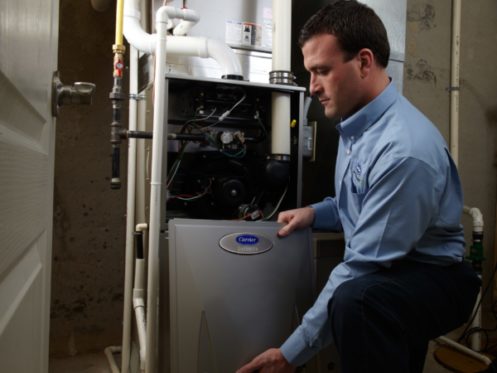Orange is the color most commonly associated with fire. However, when you look at the furnace flame in your Texas home, it better be blue. Furnace flames that are yellow, orange, or even red are always a sign of serious problems. Following is everything you need to know about furnace flame colors, including what they mean and how to respond to them.
Orange Indicates Problems With Fuel Combustion
Every gas-fired furnace burns or combusts natural gas to produce heat. If they’re installed correctly, right for the service environment, and diligently maintained, highly efficient furnaces can convert up to 98 percent of the natural gas they consume into heat. However, no gas-fired furnace is absolutely perfect in this respect. Two percent or more of the fuel that a furnace combusts is converted into exhaust gases. Incomplete fuel combustion is an inherent consequence of using these heating systems. This is why your furnace is vented to the outdoors.
Although incomplete fuel combustion and the resulting exhaust gases are a normal and expected part of your furnace’s operations, too much exhaust can be dangerous. If you have an orange furnace flame, it means that your furnace’s ability to combust fuel has been greatly altered. This could be due to a failed, dirty, or malfunctioning component, or it could be the result of having negative air pressure in your home. In either case, you should shut your heating system off right away. Your furnace shouldn’t be turned back on again until a licensed HVAC technician has diagnosed and resolved the underlying problem.
The Dangers of Using Your Heater When the Furnace Flame Is Orange
Without a properly functioning furnace vent, incomplete combustion of natural gas will release a number of contaminants into your indoor air. Among these are several volatile organic compounds (VOCs) as well as multiple types of harmful particulate matter (PM). The exhaust gases that your furnace is constantly producing while in operation include:
- Nitrogen oxide
- Methane
- Nitrous oxide
- Carbon dioxide
- Sulfur dioxide
However, the most dangerous exhaust gas being produced and released by your furnace is carbon monoxide (CO). CO is both colorless and odorless. It’s also capable of causing serious illness and death. Your home’s carbon monoxide detectors should pick up on CO gas and sound the alarm before it has the opportunity to cause illness. However, if these devices haven’t been maintained and don’t have functional batteries, you and everyone else in your home could be exposed without knowing it.
While CO gas is routed out of the building by your furnace’s venting system, certain problems that cause furnace flames to turn yellow, orange, or red actually push exhaust gases directly into the living environment.
This Is How Your Furnace Flame Should Look
A healthy furnace flame is always bright blue. A blue furnace flame means that your furnace is combusting fuel as efficiently as it can and that your exhaust system is working as it should. If you look closely, your furnace flame will also have a small triangle at its interior that’s a slightly lighter shade of blue.
In addition to having a blue color, your furnace flame should be steady. Flickering, wavering, and any other indication of an odd flame pattern are likely signs of combustion problems.
What Does a Light Yellow Tinge Mean?
Just as your furnace flame should never be orange, it should also never be completely yellow or red. However, you may have a bright blue furnace flame with a slight tinge of yellow along its outer edges. Although this isn’t necessarily a sign of impending disaster, it is cause for concern. It’s usually an indication that the furnace’s burner is dirty and that it’s time for professional maintenance.
Dealing With a Dirty or Malfunctioning Furnace Burner
One very common cause of orange furnace flames is burner trouble. If your furnace burner is dirty, it won’t be able to combust natural gas to the best of its ability fully. The less efficient fuel combustion is, the more exhaust gases your furnace will produce and the higher your home energy bill will ultimately be. You might have a dirty or malfunctioning burner if there are build-ups of soot in or around your furnace or a light but persistent burning smell in the area. Dirty and malfunctioning burners should always be cleaned, repaired, or replaced by seasoned HVAC professionals.
You May Have a Problem With Dangerous Backdrafts
Fuel combustion can be impeded by a dirty or broken burner, but it can also be affected by the dangerous backflow of exhaust gases. When this happens, the same harmful contaminants that your venting system should be expelling outside are actually getting pulled back indoors. One of the most common causes of furnace backdrafting may be surprising.
If you’ve recently taken steps to seal up your home for efficiency, this is known as creating a tight home envelope. It entails taking measures like:
- Closing off gaps and cracks in building materials
- Upgrading your windows
- Installing weatherstripping
- Increasing the R value of your home’s insulation
- Adding more insulation
Together, these efforts ensure that the heated or cooled air that your HVAC system produces isn’t simply escaping outdoors. Creating a tight home envelope is intended to lower home energy bills, limit HVAC system stress, and lower homeowners’ carbon footprints, among other things. However, when people tighten their home envelopes too aggressively, problems invariably arise.
When you’re in your home, you’re often using exhaust systems and other venting that pulls indoor air outdoors. For instance, some air is removed from your home whenever you turn your stove’s vent fan on and whenever you use the exhaust fans in your bathrooms.
If you have a fireplace, air is being pulled out of your home along with the exhaust fumes that come from burning wood. In fact, if your fireplace flue is left open, your chimney is removing air from your home all of the time. Too much exhaust and little in-flow of air can create negative air pressure. When air pressure becomes negative, venting systems start pulling outside air in and pushing exhaust gases back into the living environment.
Opening Up and Refining Your Home’s Envelope
When backdrafting is a problem, it’s important to enlist the help of a professional. Not only is backdrafting dangerous, but it’s also incredibly difficult to reverse once it’s started. An HVAC professional can help you open up and refine your home’s envelope so that indoor air pressure is balanced, fuel combustion is unimpeded, and exhaust gases go where they’re supposed to.
Extra Steps for Protecting Your Family’s Health
Scheduling routine HVAC system maintenance will ensure that burner problems are resolved before they affect fuel combustion. You should also set a schedule for inspecting and maintaining your home’s CO detectors. Backdrafting and other vent or furnace-related problems that cause CO gas to enter the home can happen anytime. Having working CO alarms is the only sure way to keep building residents safe consistently.
Contact the Professionals
Since 1992, Mackey Services, located in Dickinson, TX has been a trusted residential and commercial HVAC provider throughout the greater Houston, Texas area. We provide residential and commercial heating and cooling system repair, maintenance, and installation. We also specialize in electrical generator services. If your furnace flame is any color other than blue, call us at Mackey Services now.





